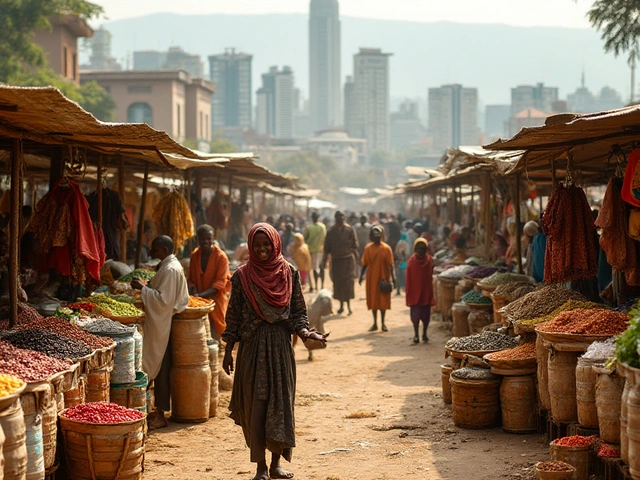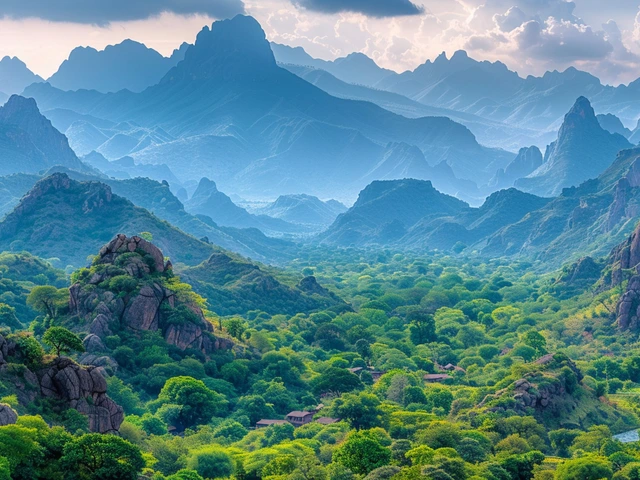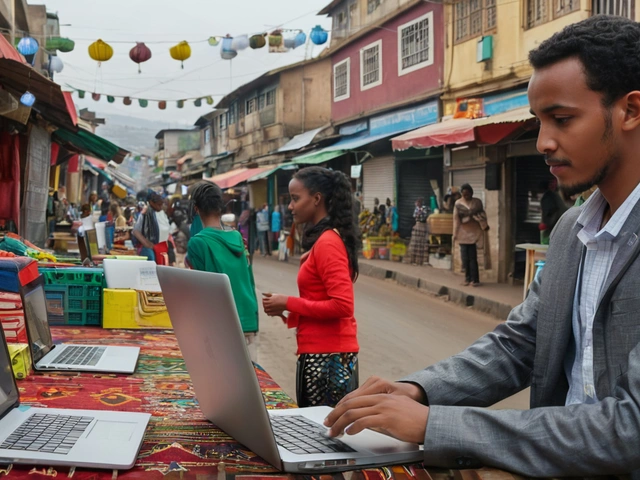The Rise of Ethiopia's Wealthy Regions
As I set out to explore the wealthiest regions of Ethiopia, I couldn't help but marvel at the country's remarkable economic progress in recent years. Ethiopia has consistently been one of the fastest-growing economies in Africa, with an average annual GDP growth rate of over 10% between 2004 and 2014
"Ethiopia has achieved impressive economic growth, averaging 10.8% a year from 2004 to 2014." - World Bank. This growth has been driven by a combination of factors, including government investment in infrastructure, a focus on industrialization, and the expansion of the service sector.
One of the most notable wealthy regions in Ethiopia is the capital city, Addis Ababa. As the political and economic hub of the country, Addis Ababa has seen significant investment in real estate, infrastructure, and business development. The city is home to numerous international organizations, embassies, and corporate headquarters, making it a prime location for business and investment opportunities.
Another region that has experienced substantial economic growth is the Oromia Region, which surrounds Addis Ababa. Oromia is known for its fertile agricultural land, making it a key contributor to Ethiopia's agricultural sector. The region has also seen the development of industrial parks, attracting foreign investment and creating employment opportunities for the local population.
Factors Contributing to Regional Wealth
Several factors have contributed to the rise of Ethiopia's wealthy regions. One of the most significant is the government's commitment to infrastructure development. The Ethiopian government has invested heavily in the construction of roads, railways, and power generation facilities, which have improved connectivity and created a more conducive environment for business and investment.
Another factor is the growth of the manufacturing sector. Ethiopia has positioned itself as a hub for light manufacturing, particularly in the textile and garment industry. The government has established industrial parks and offered incentives to attract foreign investment, leading to the creation of jobs and the growth of the manufacturing sector.
The expansion of the service sector has also played a crucial role in the development of Ethiopia's wealthy regions. The country has seen growth in the tourism industry, with an increasing number of visitors drawn to its unique cultural heritage and natural beauty. Additionally, the financial services sector has experienced significant growth, with the establishment of new banks and the expansion of mobile banking services.
Investment Opportunities in Ethiopia's Wealthy Regions
For investors looking to capitalize on Ethiopia's economic growth, the country's wealthy regions offer a range of opportunities. One area of potential investment is the real estate sector, particularly in Addis Ababa. The city's growing population and expanding middle class have created a demand for housing, office space, and commercial properties.
The agricultural sector also presents investment opportunities, particularly in the Oromia Region. With its fertile land and favorable climate, the region is well-suited for the production of crops such as coffee, sesame, and horticultural products. Investors can explore opportunities in agro-processing, value addition, and export-oriented agriculture.
The manufacturing sector is another area of potential investment, particularly in the industrial parks established by the government. These parks offer a range of incentives, including tax exemptions and streamlined bureaucratic processes, making them attractive to foreign investors.
| Region | Key Industries | Investment Opportunities |
|---|---|---|
| Addis Ababa | Real Estate, Financial Services, Tourism | Housing, Office Space, Commercial Properties |
| Oromia Region | Agriculture, Manufacturing | Agro-Processing, Value Addition, Export-Oriented Agriculture |
As Ethiopia continues its economic growth trajectory, the country's wealthy regions offer exciting opportunities for investors. With a growing middle class, expanding infrastructure, and a supportive government, Ethiopia is poised for further economic success in the years to come.

 Most Profitable Investments in Ethiopia for 2024
Most Profitable Investments in Ethiopia for 2024
 How Much Does a Decent Apartment Cost in Ethiopia?
How Much Does a Decent Apartment Cost in Ethiopia?
 How Much Do IT Managers in Ethiopia Earn in 2024?
How Much Do IT Managers in Ethiopia Earn in 2024?
 Discovering Ethiopia's Wealth: Natural and Cultural Riches Revealed
Discovering Ethiopia's Wealth: Natural and Cultural Riches Revealed
 Top Online Businesses Thriving in Ethiopia 2024
Top Online Businesses Thriving in Ethiopia 2024
RUBEN INGA NUÑEZ
April 5, 2024 AT 22:57When looking at Ethiopia's growth, it's useful to break down the data by sector and region. The capital, Addis Ababa, benefits from foreign diplomatic presence, which often translates into infrastructure projects. Meanwhile, Oromia's agricultural output fuels both domestic consumption and export markets. Keep tracking the government's investment plans to see where the next hotspots will emerge.
Michelle Warren
April 11, 2024 AT 18:57Honestly this whole “wealthy regions” happe feels like a glorified brochure.
Christopher Boles
April 17, 2024 AT 14:57Ethiopia's rise is a great case study for emerging economies. The mix of manufacturing parks and modernizing agriculture creates jobs across the board. If you’re curious about how those policies translate to everyday life, look at the recent surge in small‑scale coffee farms.
Crystal Novotny
April 23, 2024 AT 10:57We must ask why the narrative focuses solely on Addis and Oromia. Other regions hold untapped potential. The data suggests a need for broader investment.
Reagan Traphagen
April 29, 2024 AT 06:57Don't be fooled by the glossy reports. The government’s infrastructure push hides massive debt that could cripple future growth. Every new road or rail line is funded by loans that eventually come back to the taxpayers. Stay skeptical of any "miracle" claims until the numbers are audited.
mark sweeney
May 5, 2024 AT 02:57People love to hype up the capital but forget the rural heartland. The real wealth lies where the soil is fertile, not just in glass towers. Also, those industrial parks often ignore local labor rights. See beyond the smilies and hear the workers.
randy mcgrath
May 10, 2024 AT 22:57It's fascinating how quickly new manufacturing zones appear. They bring tech transfer, but the skill gap remains a hurdle. Policy tweaks to vocational training could bridge that divide.
Frankie Mobley
May 16, 2024 AT 18:57The cultural diversity of Ethiopia adds value beyond raw numbers. Traditional crafts can become export gems if the right marketing is applied. Think of weaving the story into the product.
ashli john
May 22, 2024 AT 14:57Love the optimism but remember to keep expectations grounded. Growth is a marathon, not a sprint. Celebrate milestones while staying realistic.
Kim Chase
May 28, 2024 AT 10:57It's easy to see the bright side but we cant ignore the challenges. Infrastructure puts pressure on enviroment and locals. A balanced view keeps the convo healthy.
David Werner
June 3, 2024 AT 06:57The numbers are too good to be true – a classic case of data manipulation. Every shiny new project hides a hidden cost, often paid by the common folk. Watch for the pattern: big promises, small delivery. The truth is always lurking beneath the hype.
Paul KEIL
June 9, 2024 AT 02:57From a macro‑strategic lens, Ethiopia's trajectory aligns with a classic emerging market playbook: infrastructure, industrial parks, and foreign direct investment. However, the ROI metrics are still nascent, and the sectoral heterogeneity demands nuanced risk modeling. Investors should calibrate exposure accordingly.
Horace Wormely
June 14, 2024 AT 22:57There are a few grammatical errors in the post: "has seen" should be "has seen" (correct), and "expansion of the service sector" needs a comma before "and" for clarity. Otherwise, the information is clear.
christine mae cotejo
June 20, 2024 AT 18:57Reading through the overview of Ethiopia’s burgeoning regions feels like opening a treasure chest of possibilities, each layer revealing new facets of economic vibrancy that many outside observers often overlook. The capital, Addis Ababa, stands as a beacon of modernity, its skyline dotted with rising towers that symbolize both ambition and the influx of multinational corporations seeking a foothold in East Africa. Yet, beneath the glitter of glass and steel, the city's heartbeat still resonates with centuries‑old traditions, reminding us that progress does not erase heritage. Moving outward, the Oromia Region presents a contrasting tableau: vast swaths of fertile land that have long fed the nation, now intertwined with state‑backed industrial parks that promise to transform agricultural output into value‑added products for global markets. This duality-a blend of time‑honored farming and cutting‑edge manufacturing-embodies the very essence of Ethiopia’s development narrative. Moreover, the government’s deliberate push to enhance transportation corridors, from highways to railways, acts as the circulatory system enabling the free flow of goods, labor, and ideas across provincial borders. Such infrastructure not only reduces transaction costs but also attracts foreign investors who view connectivity as a prerequisite for sustainable ventures. The service sector, too, has not been left behind; the rise of mobile banking and fintech solutions has empowered previously unbanked populations, fostering financial inclusion and stimulating consumer spending. Tourism, leveraging the country's rich cultural mosaic and stunning landscapes, is carving out a niche that complements the industrial agenda, offering diversification that softens economic shocks. As investors contemplate entry points, real estate emerges as a compelling arena, especially in urban centers where demand for housing outpaces supply, driving both rental yields and property appreciation. Simultaneously, agro‑processing stands poised to capture higher margins by moving beyond raw commodity exports toward packaged, branded goods that cater to international taste buds. In the manufacturing sphere, incentives such as tax holidays and streamlined licensing within the industrial parks lower barriers to entry, making Ethiopia an attractive destination for textile, garment, and light assembly operations. Collectively, these dynamics weave a tapestry of opportunity that, while still in its early stages, signals a promising trajectory for those willing to engage with the country’s evolving market landscape.
Douglas Gnesda
June 26, 2024 AT 14:57Great breakdown! The synergy between infrastructure projects and sectoral growth is evident. Investors should also monitor policy updates; changes can impact incentives quickly. Keeping an eye on regional trade agreements will be crucial for long‑term strategies.
Abhijit Pimpale
July 2, 2024 AT 10:57Ethiopia's GDP growth figures are impressive, but they mask inequality gaps. Policy focus must shift toward inclusive development.
Eric DE FONDAUMIERE
July 8, 2024 AT 06:57Spot on analysis! The push for industrial parks is exciting, but remember the importance of local workforce training. Without skilled labor, the parks could underperform.
Pauline Herrin
July 14, 2024 AT 02:57The article provides a thorough overview; however, further scrutiny of fiscal sustainability is warranted. A balanced assessment will benefit prospective stakeholders.
pradeep kumar
July 19, 2024 AT 22:57While the growth narrative sounds promising, hidden debt liabilities could undermine future stability. Investors must demand transparency.